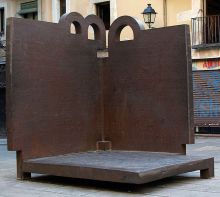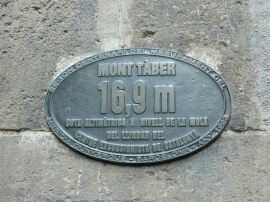The hidden neighbourhood of La Ribera is known for its beautiful gothic mansions, small streets and good restaurants. However, if there are two things you can’t miss they are the Santa Maria del Mar, a church built in the fourteenth century, and the old market of El Born.
 Santa Maria del Mar is the only fully finished gothic church in all Catalonia. Designed by the architect Berenguer de Montagut, it has a beautiful entrance with numerous arches and sculptures. Inside, there is a feeling of space achieved with a clever use of light coming though strategically placed rose windows. Outside, just in front of the church there is a lovely gothic fountain dedicated to Saint Maria.
Santa Maria del Mar is the only fully finished gothic church in all Catalonia. Designed by the architect Berenguer de Montagut, it has a beautiful entrance with numerous arches and sculptures. Inside, there is a feeling of space achieved with a clever use of light coming though strategically placed rose windows. Outside, just in front of the church there is a lovely gothic fountain dedicated to Saint Maria.
The old cemetery of the Santa Maria del Mar church known as Fossar de les Moreres, has become an important symbol for Catalans. Here are buried the soldiers that defended the city from the family Borbon’s troops – nowadays the Spanish Royal Family – in 1714. On one side there is a plaque with a poem by Frederic Soler called “Pitarra” that in english says: “to all martyrs of 1714, in the Fossar de les Moreres no traitors are buried; until we lose our flags, it will be a place for people with honor”. The gas light in the middle is lit all year around to remember the people that died defending Catalunya and its traditions.
The street to the left of the church takes you straight to Carrer Montcada. Opened in the fourteenth century, used to be home to the richest families of Barcelona. Its “small” gothic palaces are charming and every one of them deserves, at least, a short look.
Palau Cervelló (Montcada, 25) is a building that dates from the end of the fifteenth century, built by the Cervelló Family, one of the richest in Barcelona at that time. The structure is common in Catalonia’s gothic style and the interior garden is beautifully conserved. Nowadays it belongs to the art gallery Maeght and is used for art expositions.

Further along, the amazing Picasso Museum (Carrer Montcada 15-19) takes up to three medieval palaces on Montcada street. The building has been really well refurbished and adapted to the necessities of a museum (the interior patios are really beautiful and done with great taste). The palace is also home to a collection of the world famous artist, Pablo Picasso. The museum opens everyday except monday from 10am to 8pm and the tickets are 11€ per adult and 8€ for students. More information about the expositon can be found here.
Another iconic building of La Ribera is the Mercat del Born, at Plaça Comercial. built by Josep Fontseré and Josep Maria Cornet, it is an imposing building that used to be a fruit and vegetable market until 1979, when it was refurbished. At the entrance there is a nice avenue called Avinguda del Born with modernist street lights as well as different sculptures. There are numerous bars and restaurants perfect for a short rest.
 El Palau de la Música is the clearest example Catalan’s Modernist Architecture. Designed by Lluís Domenech i Montaner it has been a UNESCO World Heritage site since 1997. The building has continuous references to music and Catalonia, reasons why it is an important symbol for Catalans. The palace hosts regular classical music concerts as well as being known as the headquarters of the oldest Catalan Choir, the Orfeó Català. Inside, you can’t miss the auditorium with a stunning skylight at the centre and amazing sculptures at the stage. El Palau – how locals call it – has guided tours everyday from 10am to 3.30pm for 15€ per adult has a maximum of 55 visitors a day. More information can be found here.
El Palau de la Música is the clearest example Catalan’s Modernist Architecture. Designed by Lluís Domenech i Montaner it has been a UNESCO World Heritage site since 1997. The building has continuous references to music and Catalonia, reasons why it is an important symbol for Catalans. The palace hosts regular classical music concerts as well as being known as the headquarters of the oldest Catalan Choir, the Orfeó Català. Inside, you can’t miss the auditorium with a stunning skylight at the centre and amazing sculptures at the stage. El Palau – how locals call it – has guided tours everyday from 10am to 3.30pm for 15€ per adult has a maximum of 55 visitors a day. More information can be found here.
[Pictures via Raquel Gella except: Santa Maria del Mar via Visit-Bcn and Palau de la Musica via Josep Renalias]










